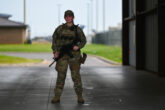October 24, 2017
John McCain's 'Bone Spurs' Comment Shows There's a Deeper Problem in the Military
Sen. John McCain’s recent comments about the wealthy avoiding service in Vietnam through deferments not only took an unsubtle swipe at the current commander-in-chief, but also highlighted the key inequities that characterized the draft-era military. While the implementation of the all-volunteer force effectively removed those class disparities over time, the military remains unrepresentative in other important ways.
As McCain highlighted, the proposition of conscripted service in Vietnam was deeply unfair. Affluent draft selectees could obtain deferments for college or medical reasons with relative ease and as a result, The Washington Post notes, nearly “80 percent of those who served in Vietnam came from working-class families.”
The end of both the war and the draft, however, reset the composition of the military. Through the expansion of the all-volunteer force in the 1980s, and subsequent growth and reductions since, the class divide in the military all but disappeared. Several studies of the affluence levels in the neighborhoods of enlisted recruits show that the military is almost completely balanced in its representation of socio-economic groups, if only barely over-representative of the middle class. A prominent report by the research organization CNA indicates that enlisted accessions into the military in 2015 were slightly over-representative of the middle three economic quintiles, while they slightly under-represented the poorest and richest segments of America. From the perspective of socio-economic class, military service is considerably more equitable in today’s society.
Read the full op-ed in Fortune.
More from CNAS
-
National Security Human Capital Program
Short SupplyExecutive Summary The U.S. military faces a critical challenge: Fewer young Americans are willing to serve, and fewer adults are encouraging them to do so. Because of delibera...
By Katherine L. Kuzminski & Taren Sylvester
-
National Security Human Capital Program
Defending the Army’s Command Assessment ProgramThe concept for CAP — developed during the first Trump administration — benefited from the guidance, input and oversight from the foremost scholar and practitioner on military...
By Katherine L. Kuzminski
-
National Security Human Capital Program
‘Women Don’t Just Achieve…They Excel’: Fmr. Marine Corps Attack PilotDr. Kyleanne Hunter, former Marine Corps attack pilot and CEO of Iraq & Afghanistan Veterans of America, says “women are the fastest growing group of veterans” and “the fastes...
By Dr. Kyleanne Hunter
-
National Security Human Capital Program
A Workforce Strategy for America’s Shipbuilding FutureThe future of American maritime dominance will not be determined solely by the number of ships launched or contracts signed, but rather by the strength and sustainability of t...
By Katherine L. Kuzminski & Laura Schmiegel




